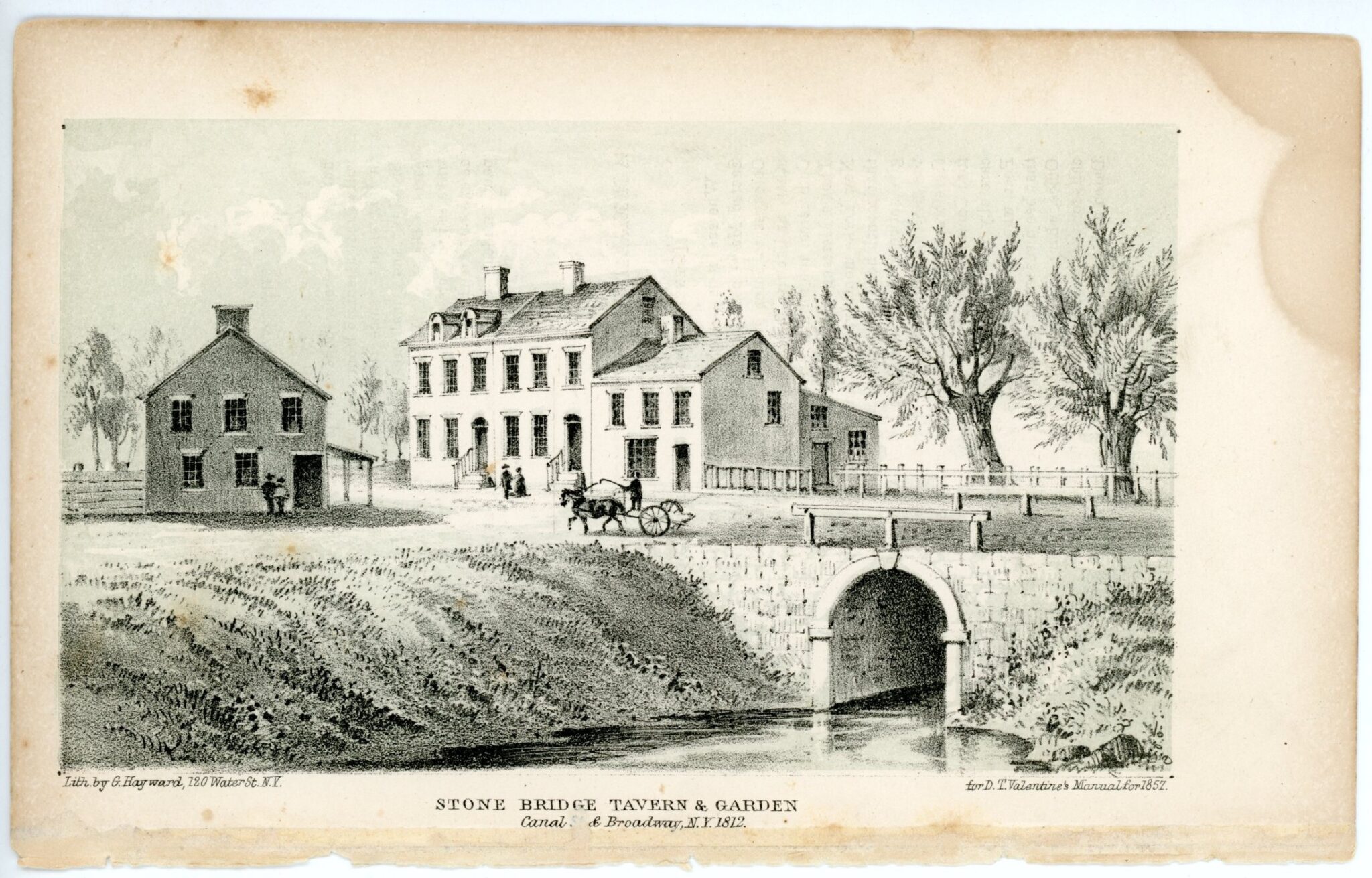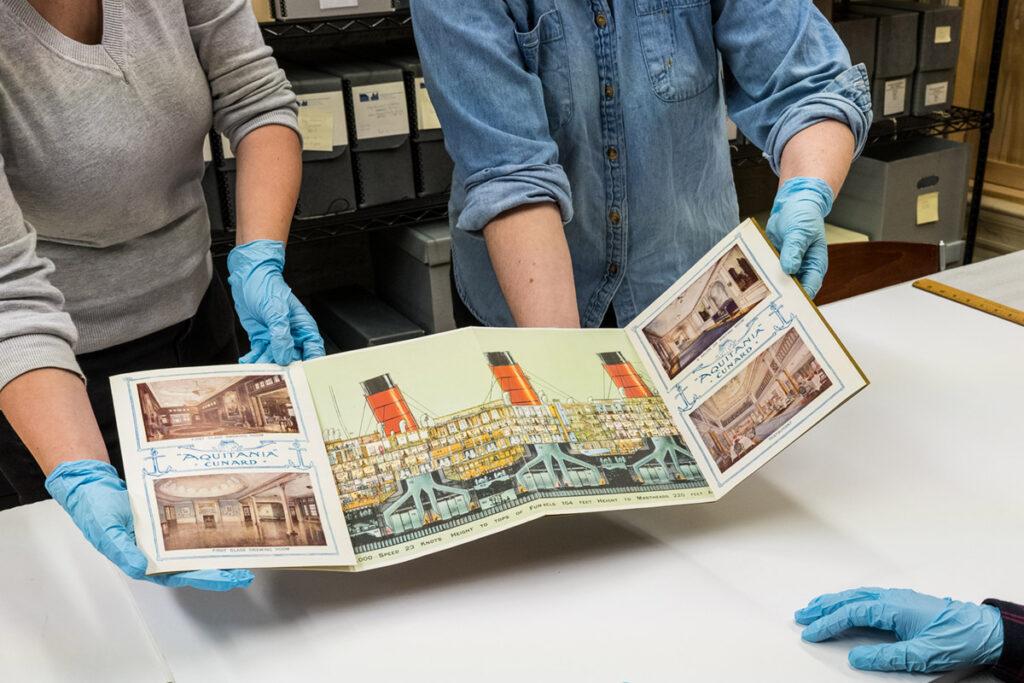A look at the stories behind a handful of Manhattan’s taverns in history
A Collections Chronicles Blog
by Carley Roche, Collections and Archives Intern
June 18, 2020
Hello everyone, this is Carley, Collections and Archives Intern at the Seaport Museum! Due to coronavirus (COVID-19) my internship has been completed remotely. While at home, I have been searching through digital copies of D.T. Valentine’s Manual of the Corporation of the City of New York to update the Museum’s collection management database records, and prints, tied to this publication.
It has been fascinating pulling back the curtain on old New York: seeing what has changed over the centuries and what has stayed the same. One thing that clearly has not changed is the love of going out with friends, gossiping, and having a few drinks over a nice meal. With the news recently focusing on re-opening the country, I find myself excited at the prospect of returning to restaurants and bars. Manhattan has been the home to thousands of bars over its long history, and I think we should take a look at the stories behind a handful of these taverns.
Bull’s Head Tavern
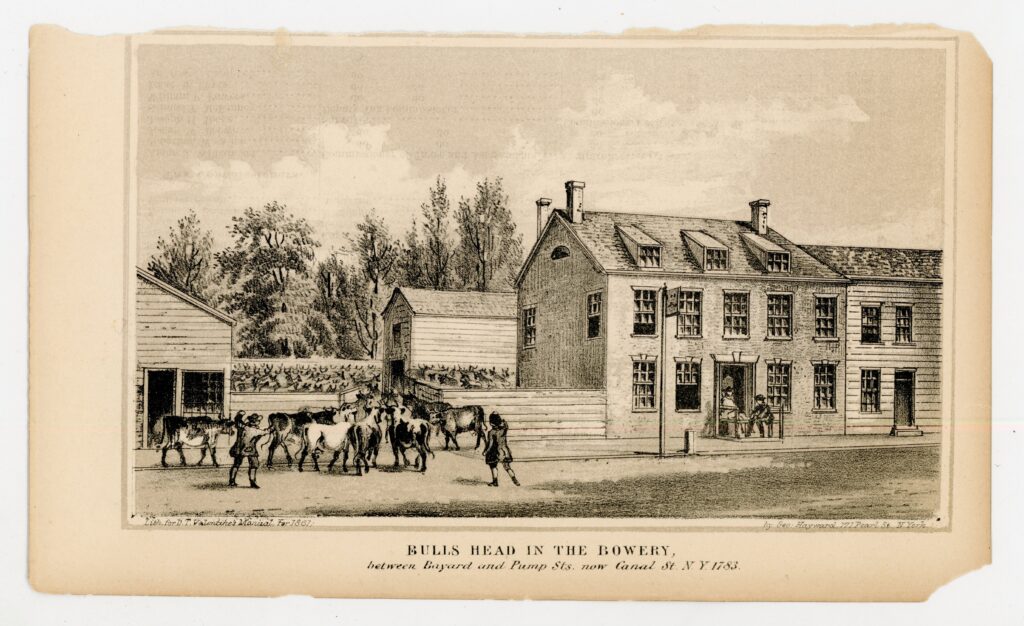
Originally built around 1750, the Bull’s Head Tavern established itself in the Bowery neighborhood between Bayard and Pump (now Canal) Streets. The Bull’s Head was surrounded by livestock yards, tanneries, and slaughterhouses making it the perfect place for butchers, tradesmen, and ranchers to meet and discuss business. The tavern was also “the last halting-place for the stages before entering the city” [1] Cutting, E.B. Old Taverns and Posting Inns In Historic New York, Volume 2. (pp. 261) due its location just outside New York City’s official limits. It became the established spot for exchanging business, news, and gossip in the late 18th and early 19th centuries.
Guests of the Bull’s Head also engaged in the then popular pastime of bear baiting as well as plenty of gambling—giving the Bull’s Head a rowdy and hardened reputation. However it was on November 25, 1783 that the Bull’s Head cemented its place in history as it became the temporary headquarters for George Washington and his regiment. While the British Army fled New York City at the end of the American Revolution, George Washington used this stop to gather his troops before re-entering New York City victorious over the British. Eventually, as the city expanded north, wealthy New Yorkers moved into the Bowery neighborhood, and they wanted the Bull’s Head—and its clientele—out of the area. Owner Henry Astor agreed to change locations moving the tavern outside of the city limits once again to E 24th Street and 3rd Ave. The Bull’s Head survived at this location until the 1830s. [2] Burrows, E.G. & Wallace, M. Gotham: A History of New York City to 1898. [3] Bowery Boys. Remnants of the Bull’s Head Tavern: Could this be the greatest New York archaeological find of the year? [4] Barron, J. Unearthed: A possible stop along the Revolution
Buckhorn Tavern
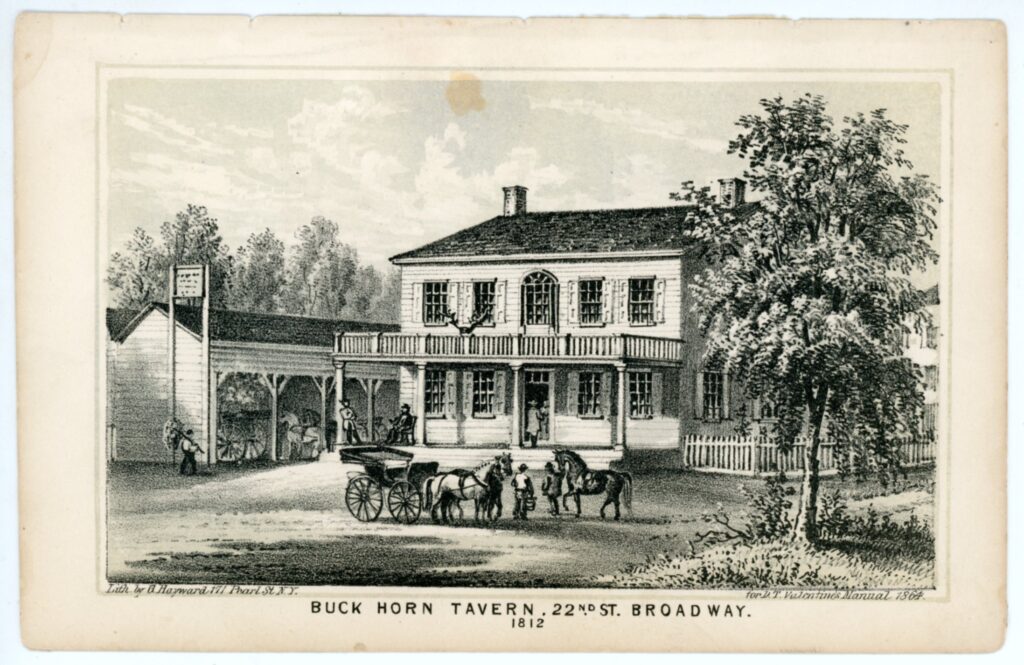
A well-loved tavern for rest and drinks, the Buckhorn (sometimes read as Buck’s Horn) Tavern was the place to stay for those traveling from upstate New York, Boston, or the farms in Manhattan. Located at 22nd Street and Bloomingdale Road (Broadway), the idyllic countryside tavern allowed travelers a place to rest their horses in the attached stables, unwind with ten-pin bowling, or simply exchange news and gossip over ale and a meal.
The Buckhorn Tavern had been owned by the Horn family since the early 1700s and over the next century cemented its position as an influential location outside of New York City. By 1830, the Buckhor became the official political meeting place for the city’s 12th Ward due to the city’s continual expansion northward. A thriving tavern, the Buckhorn was a central player in New York’s early political, social, and economic scenes. Unfortunately, in the early hours of September 6, 1842, a fire tore through the stables and tavern ending the business of the beloved Buckhorn. [5] Miller, T. The Lost Buck’s Horn Tavern – Broadway and 22nd Street [6] Ephemeral New York. Stopping at the Buckhorn Tavern on 22nd Street
Stone Bridge Tavern

Another tavern enjoyed for its location just outside of the city’s limit was the Stone Bridge Tavern. Not much is known about the tavern, once found at Broadway and Canal Street (then an actual canal), except many who visited were simply seeking a short respite from the urban sprawl of New York City. What is known is that the pictured stone bridge was built during the Revolutionary War era and most likely by British soldiers. The canal that cut through Lower Manhattan was eventually drained and paved over sometime between 1817 and 1819 to continue the growth of the city.
Today, there are no longer any remains of the tavern at the south-west corner of Broadway and Canal Street –instead the National City Bank of New York can be found there. Still, the Stone Bridge Tavern was once a lively place to escape the city as it “was often referred to in writings of the period.” [7] Forgotten NY. Canan Street, SOHO-les [8] Kadinsky, S. Lispenard’s Meadow, Manhattan [9] Amell, R. The Truth About Broadway- And Manhattan’s Water Border
Blue Bell Tavern
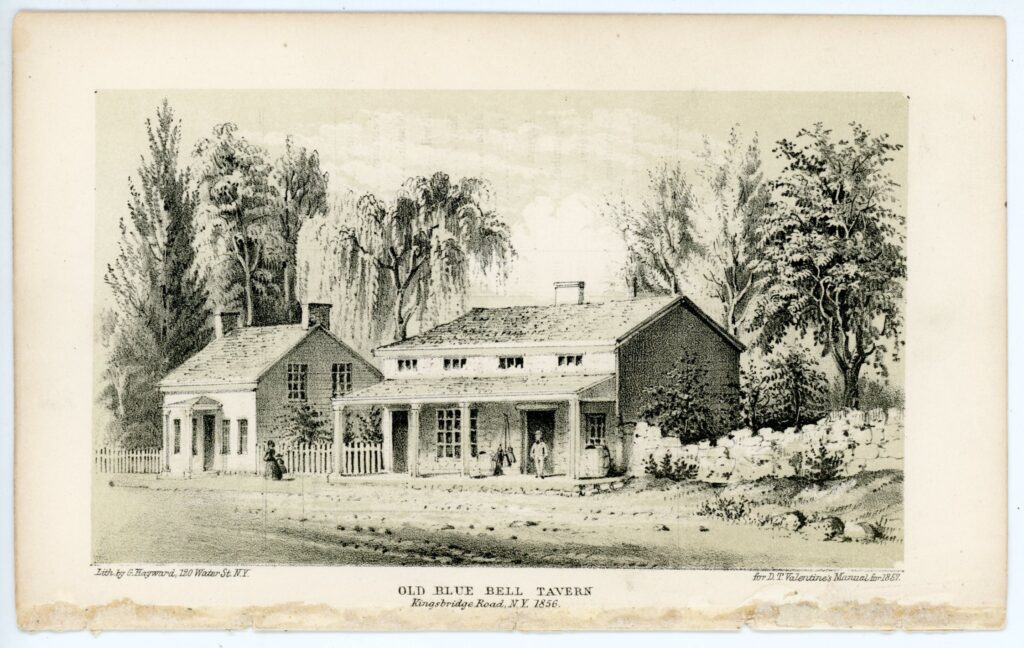
Moving further up the island of Manhattan once stood the Blue Bell Tavern. Previously located at 181st Street and Bloomingdale Road, this tavern’s history began as a simple home built sometime between 1725 and 1730. Over the years, it transformed as an inn for weary travelers due to its location into and out of Manhattan.
The Blue Bell Tavern was home to luscious gardens, which allowed for hosting puppet and music shows. Politicians also found comfort in the tavern –such as New York colonial Governors Cadwallader Colden and James De Lancey– to trade news and find rest during their travels. During the American Revolution, British, American, and Hessian troops frequently used the Blue Bell as temporary headquarters.
On his march back to New York City, much like his stay at the Bull’s Head, George Washington used the Blue Bell for the evening of November 22, 1783 to oversee the evacuation of British soldiers three days later. Unfortunately, business slowed as people moved closer to the city and the Blue Bell saw many ownership changes over the next century. In 1915, the Blue Bell was officially dismantled to make way for the RKO Coliseum theater. [10] Bowery Boys. Blue Bell Tavern: War and romance in Washington Heights [11] Washington Heights NYC. Blue Bell Tavern [12] New York Historical Society. Blue Bell Tavern, New York City
COVID-19 has drastically changed everyone’s lives. Although things are, and will continue to be difficult we should try to remember places and people who bring joy to our lives. Of course we all miss going to dinner with our friends, grabbing a drink after work, or catching up with an old friend at a favorite haunt. Until we are safe enough to return to our own modern taverns we should all continue to stay safe indoors and raise a glass to New York City’s past and future restaurant scene.
Research Policies
Conducting research is a vital part of the Seaport Museum’s work. The Museum is actively engaged in a complete inventory of its collections and archives. This ongoing project will improve future public access to the materials in our care and ensure that items are documented and preserved for future generations.
References
| ↑1 | Cutting, E.B. Old Taverns and Posting Inns In Historic New York, Volume 2. (pp. 261) |
|---|---|
| ↑2 | Burrows, E.G. & Wallace, M. Gotham: A History of New York City to 1898. |
| ↑3 | Bowery Boys. Remnants of the Bull’s Head Tavern: Could this be the greatest New York archaeological find of the year? |
| ↑4 | Barron, J. Unearthed: A possible stop along the Revolution |
| ↑5 | Miller, T. The Lost Buck’s Horn Tavern – Broadway and 22nd Street |
| ↑6 | Ephemeral New York. Stopping at the Buckhorn Tavern on 22nd Street |
| ↑7 | Forgotten NY. Canan Street, SOHO-les |
| ↑8 | Kadinsky, S. Lispenard’s Meadow, Manhattan |
| ↑9 | Amell, R. The Truth About Broadway- And Manhattan’s Water Border |
| ↑10 | Bowery Boys. Blue Bell Tavern: War and romance in Washington Heights |
| ↑11 | Washington Heights NYC. Blue Bell Tavern |
| ↑12 | New York Historical Society. Blue Bell Tavern, New York City |

